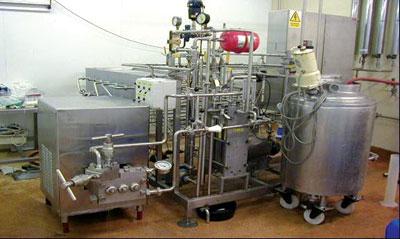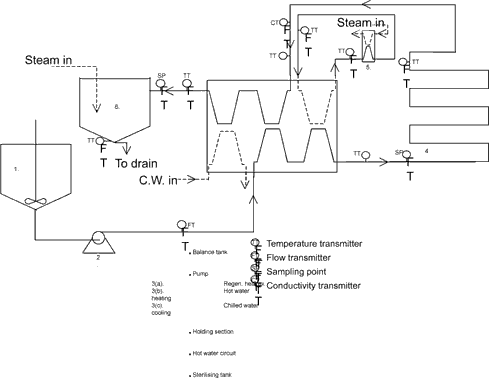 Pilot plant pasteuriser
Mycobacterium avium
subsp.
paratuberculosis
(Map) is the cause of Johne's disease, a severe intestinal inflammation in ruminants. It has been suggested that Map is the cause of Crohn's disease, a similar type disease in humans, though whether similarities in the histopathologies of the two diseases are real or merely superficial has yet to be resolved. Potential sources for Map infection in humans include milk and contaminated water supplies. The reported survival of Map in laboratory pasteurisation studies is a cause for concern, raising the possibility that retail supplies of pasteurised milk could contain the organism.
Pilot plant pasteuriser
Mycobacterium avium
subsp.
paratuberculosis
(Map) is the cause of Johne's disease, a severe intestinal inflammation in ruminants. It has been suggested that Map is the cause of Crohn's disease, a similar type disease in humans, though whether similarities in the histopathologies of the two diseases are real or merely superficial has yet to be resolved. Potential sources for Map infection in humans include milk and contaminated water supplies. The reported survival of Map in laboratory pasteurisation studies is a cause for concern, raising the possibility that retail supplies of pasteurised milk could contain the organism.
In the dairy industry, high temperature short time (HTST) pasteurisation is a critical control step for ensuring the microbiological safety of milk and dairy products, as most bacterial and viral pathogens are destroyed in this process. However, thermoduric species will survive, and the recent reported survival of Map, and its presence in pasteurised milk has raised safety concerns.
We set out to establish the heat resistance of Map in raw milk under pilot plant conditions, simulating the industrial pasteurisation process.
 Flow diagram for pilot plant pasteuriser
A custom designed, dedicated pilot plant pasteuriser with computerised control of operating and recording parameters was installed in a Class 2 facility at Moorepark. Pasteuriser performance was confirmed with respect to operating temperatures, holding times, and flow characteristics of the plant. In a series of 16 pasteuriser trials, 4 laboratory strains of Map were inoculated into raw milk at concentrations ranging from 4.0 x 10
2
to 2.0 x 10
5
cfu/ml. It is of critical importance that Map, unlike most other pathogens cannot replicate in milk so numbers can only remain static or decline. The milk was heated under industrial pasteurisation HTST turbulent flow conditions of 72.5
0
C x 27s. No survivors were detected in any of the trials. A 24-48h resuscitation step before analysis was included as a recovery step for heat damaged cells. In addition, the chemical decontamination step (which is necessary to inactivate contaminants, but can reduce Map numbers) normally used during analysis, was not applied. Other species of the genus
Mycobacterium
i.e.
M. smegmatis
and
M. fortuitum
, when inoculated into milk at 10
4
-10
5
cfu/ml, were also inactivated on HTST pasteurisation. Inclusion of a homogenisation step upstream of the plate heat exchanger effected a small increase in cell numbers (ca. 0.5 log
10
), possibly as a result of declumping, though again Map was not shown to survive the HTST conditions.
Flow diagram for pilot plant pasteuriser
A custom designed, dedicated pilot plant pasteuriser with computerised control of operating and recording parameters was installed in a Class 2 facility at Moorepark. Pasteuriser performance was confirmed with respect to operating temperatures, holding times, and flow characteristics of the plant. In a series of 16 pasteuriser trials, 4 laboratory strains of Map were inoculated into raw milk at concentrations ranging from 4.0 x 10
2
to 2.0 x 10
5
cfu/ml. It is of critical importance that Map, unlike most other pathogens cannot replicate in milk so numbers can only remain static or decline. The milk was heated under industrial pasteurisation HTST turbulent flow conditions of 72.5
0
C x 27s. No survivors were detected in any of the trials. A 24-48h resuscitation step before analysis was included as a recovery step for heat damaged cells. In addition, the chemical decontamination step (which is necessary to inactivate contaminants, but can reduce Map numbers) normally used during analysis, was not applied. Other species of the genus
Mycobacterium
i.e.
M. smegmatis
and
M. fortuitum
, when inoculated into milk at 10
4
-10
5
cfu/ml, were also inactivated on HTST pasteurisation. Inclusion of a homogenisation step upstream of the plate heat exchanger effected a small increase in cell numbers (ca. 0.5 log
10
), possibly as a result of declumping, though again Map was not shown to survive the HTST conditions.
Two natural Map isolates, one obtained from raw milk and the other from a faecal sample, were cultured, added to milk at 10
3
-10
4
cfu/ml, and subjected to pasteurisation at 72.5
0
C x 27s. Again, no survivors were detected following HTST treatment.
It is concluded from these experiments that HTST pasteurisation is effective in controlling Map, achieving a minimum 4 log10 reduction in cell numbers. Low excretion of Map into milk coupled with good hygienic milking practices and large dilution effects during milk assembly is likely to result in small numbers (if any) of the organism in raw milk at the processing plant. The high numbers of Map used in pasteuriser experiments described here have never been recorded in raw milk. These results do not support the contention that Map is a public health issue in the proper supply and manufacture of correctly pasteurised product.
Contact: Dr Kieran Jordan
Tel: 025 42451
E-mail:
[email protected]
|


